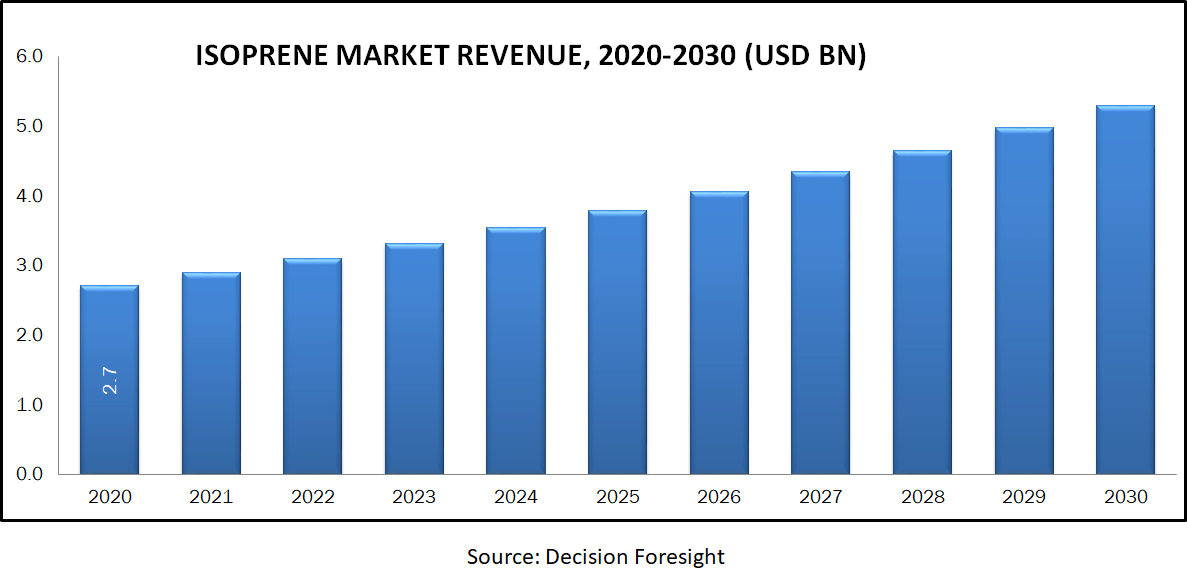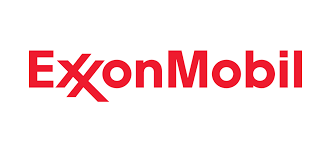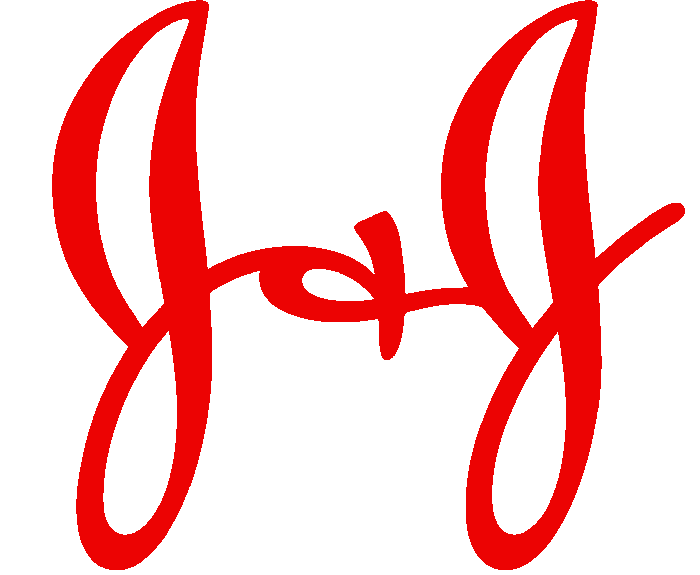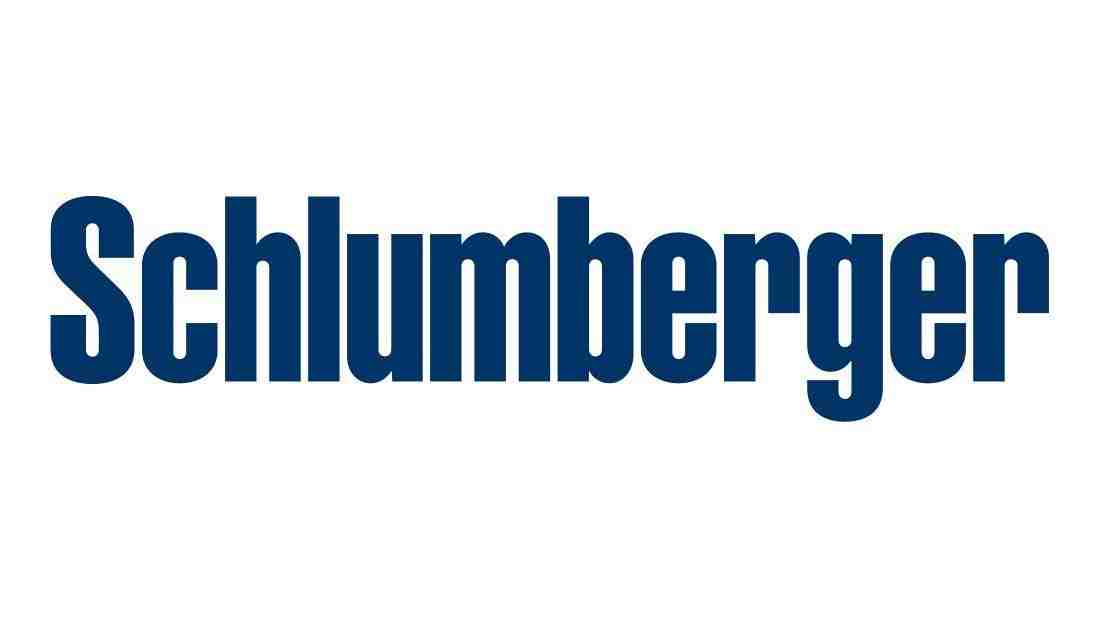Isoprene Market size is anticipated to reach USD 5.3 billion by 2030, at CAGR of 7.0% between 2020 and 2030. Isoprene is a volatile liquid, colourless and unsaturated hydrocarbon. Isoprene is produced by many animals and plants and moreover it is also produced and emitted by many species of trees. Major such producers are poplars, oaks, eucalyptus and some legumes. Annual production of isoprene emissions by vegetation is around 600 million metric tons, half from tropical broadleaf trees and the rest mainly from shrubs. Polyisoprenes are used in wide range of rubber applications such as baby bottle nipple, medical equipment, toys, shoe soles, threads for golf balls or textiles and elastic films. According to International Natural Rubber Study Group, the demand for natural rubber is expected to be driven by developing end-user market such as automotive, footwear, and construction, among others. Increasing production of natural rubber shall steer the product market growth over the forecast period. Similarly, growing demand of personal vehicles will fuel market growth. Development of these industries in emerging economies such as India, Malaysia, and Brazil will spur the product demand during forecast period. Approximately 95% of isoprene is used for rubber synthesis, and approximately 20 million tons of rubber is produced annually.
Market Segmentation:
On the basis of type, the isoprene market can be divided into polymer grade and chemical grade. Based on applications, the market is categorised into polyisoprene, styrene isoprene styrene, isobutyl isoprene rubber. Based on end user industry the market is distributed into tires, non-tires, and adhesives. By geography the market is divided into regions comprising North America, Europe, Asia-Pacific, and RoW.
Market Dynamics and Factors:
Growing demand for synthetic rubber across several industries verticals, tied with increasing adoption of isoprene in manufacturing of synthetic rubber is a key factor likely to drive the global isoprene market growth. Additionally, rapid industrialization in developed and developing countries and rising demand for technological advanced material that has high absorbency properties are some other features likely to increase growth of the market. Additional factor driving the demand for synthetic rubber include its use in the medical industry for tubing, medical gloves, catheters, and diaphragms. In the construction industry, isoprene is used in pipes, flooring, windows, roofing, sound insulation, cladding, and electrical cables. Increasing construction industry across the globe due to fast-paced industrialization and urbanization is features likely to fuel the demand for isoprene market during the review period. Global Construction 2030 – estimates the capacity of construction output will develop by 85% to USD 15.5 trillion worldwide by 2030, with three countries – China, US and India – leading the way and accounting for 57% of all global growth. Moreover, use of rubber in sports and leisure goods such as mouth guards, soccer gloves, footballs, inflatable balls, soccer balls, basketball hoops, agility hurdles, and basketball nets is expected to boost the product demand. Isoprene is broadly used in the manufacturing of tires, due to its properties, such as flexibility, tensile strength, tear strength, etc. World demand for tires is likely to rise 4.1% per year to 3.0 billion units in 2019. In value terms, sales of tires are estimate to advance 7.0 % annum to USD 258 billion. Increasing incomes in developing regions will spur growth in the number of vehicles in use, fuelling demand for tires. Demand for tires in motorcycle and other applications is projected to advance 5.8 % per year to 990 million units in 2019. Increasing incomes in developing regions will grow in the number of vehicles in use, fuelling demand for tires. Though, strict government regulation in rubber manufacturing industry is a key factor projected to hamper growth of the global isoprene market. However growing investment for R&D activities by key players for development of rubber with improved performance and with low rolling resistance is expected to create potential revenue opportunities for players during the forecast period.
Geographic Analysis:
Asia Pacific region in 2018 dominated the global isoprene market in terms of volume, owing to its growing automotive and construction industries. Furthermore, the rising demand for isoprene for tire production is projected to fuel the isoprene market over the forecast period. Likewise, the growing construction activities and the growing infrastructural investments in India and China are projected to further boost the isoprene market growth in the upcoming years. The technological advancements observed in the production process of isoprene are likely to offer new development opportunities to the regional market players. North American isoprene market is projected to grow significantly over the assessed time period, owing to increase production capacities, high consumption potential, and increasing economic growth. U.S. and Canada are the key contributors toward this regional market, due to the flourishing automotive medical industries. The European automotive industry is growing rapidly which in turn, is assessed to fuel the application of isoprene to produce various automotive components, such as engine mounting, tires, fuel hoses, mud flaps, and floor mats. The increasing expenditure related to automobile innovation and cosmetic products tied with the increasing purchasing power of consumers is likely to drive the isoprene market growth in Europe. Germany, UK, and Italy are the key contributors of isoprene, owing to the existence of prominent automobile producers in these countries.
Competitive Scenario:
The market is dominated by various major participants including Kuraray Company Ltd. ExxonMobil Corp., LyondellBasell Industries N.V., Shandong Yuhuang Chemical (Group) Co., Ltd., Braskem and The Goodyear Tire & Rubber Company.
Isoprene Market Report Scope
| Report Attribute | Details |
| Analysis Period | 2020–2030 |
| Base Year | 2021 |
| Forecast Period | 2022–2030 |
| Market Size Estimation | Billion (USD) |
| Growth Rate (CAGR%) | 7.0 % |
|
| By Type (Polymer Grade and Chemical Grade), By Applications (Polyisoprene, Styrene Isoprene Styrene, and Isobutyl Isoprene Rubber), By End User Industry (Tires, Non-tires, and Adhesives) |
| Geographical Segmentation | North America (U.S., Canada, Mexico) Europe (UK, Germany, Italy, France, Rest of Europe), Asia-Pacific (China, Japan, India, Australia, Rest of APAC), South America (Brazil, Argentina, Rest of SA), MEA (UAE, Saudi Arabia, South Africa) |
| Key Companies Profiled | Kuraray Company Ltd. ExxonMobil Corp., LyondellBasell Industries N.V., Shandong Yuhuang Chemical (Group) Co., Ltd., Braskem and The Goodyear Tire & Rubber Company. |
|
|
|







